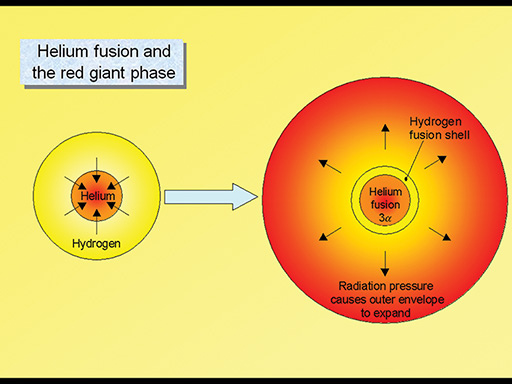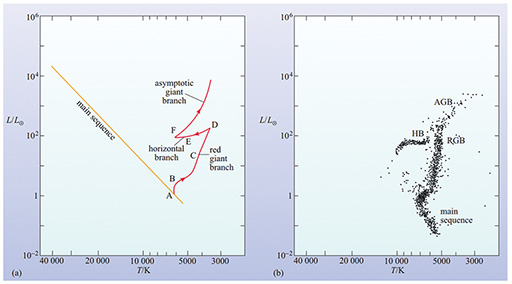1.2 Expansion and the red giant branch
Your answers to Activity 1 will have told you two things: that helium fusion requires more extreme conditions in the core of a star than hydrogen fusion, and that it can only provide a brief respite against the eventual gravitational collapse of the star.
This is clearly going to be a much less stable phase of the star’s life than its previous existence on the main sequence. Perhaps curiously, the star does not immediately start to contract under gravity, and in fact the outer layers of the star will continue to be supported for a while and will eventually expand.
To understand this, think back to the zigzag path that radiation takes on its way out from the core as shown in Figure 6 last week. The multiple collisions between the outgoing radiation and charged particles in the dense material in the star’s interior provide the radiation pressure that helps to support the star. These repeated collisions also slow the progress of the energy; in a star such as the Sun it can take up to a million years for the radiation to work its way from the core to the surface. This means that the outer layers can still be supported by radiation pressure for a significant time after the supply of energy in the core dies down. While the last gasps of this energy are still holding up the outer layers, the core of the star will be the first part to start collapsing, as shown in Figure 2.

As the core starts to contract, gravitational energy is released. This causes the core temperature and pressure to increase as it becomes more compressed. The first consequence of this is that further hydrogen fusion will be triggered, both in the core – as any remaining hydrogen is subjected to these more extreme conditions – and in a thin shell of unused hydrogen around the core that is now heated enough to undergo fusion. The energy released by this new burst of fusion increases the radiation pressure on the outer layers, causing them to start expanding and taking the star from point A to D on the HR diagram in Figure 3.

At point D, the core has become sufficiently compacted for helium fusion to start – particularly for smaller stars this is a very unstable process and can take place very rapidly in a runaway reaction known as the helium flash. This heats the star further, taking it from E to F on the diagram. After point F, helium fusion starts in a shell surrounding the core, much as it did for hydrogen, resulting in further expansion of the outer envelope, which cools as it expands, moving the track upward and to the right on the diagram. The star is well on its way to becoming a red giant.
